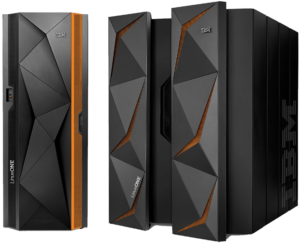As an industry analyst with one foot in the cloud-native world and the other in the mainframe, the myths and misperceptions about the mainframe continue to mystify me.
The reality: when you look closely, today’s mainframe bears surprisingly little resemblance to the big iron of old. And nowhere do mainframe myths and reality diverge as broadly as with LinuxONE.
Separating Myth from Reality

With IBM LinuxONE III, Big Blue’s latest release of its Linux-only mainframe offering, the company has rolled out a truly impressive piece of gear that puts today’s cloud servers to shame.
Here are the reasons this beast of a machine puts the kibosh on seven common mainframe myths.
Mainframe Myth #1: Mainframes have specialized operating systems that require specialized skills
Fact: IBM has mainframe operating system combinations for every need, from the powerful IBM z15 mainframe running z/OS, to the hybrid z/OS and Linux on Z running on the z15 in separate partitions, to LinuxONE.
In fact, LinuxONE mainframes run Linux natively – that is, on bare metal hardware. Anything you can run on Linux, you can run on LinuxONE, including Kubernetes, for example. LinuxONE runs several flavors of Linux, including Canonical Ubuntu, SUSE Linux Enterprise Server, and Red Hat Enterprise Linux – and IBM is bringing Red Hat OpenShift to LinuxONE as well.
Mainframe Myth #2: Mainframes are more expensive than distributed alternatives, either on-premises or in the cloud.
Fact: For its z/OS mainframes, IBM has always offered a pay-for-use pricing model, which it recently revamped with the lower cost Tailored Fit Pricing.
LinuxONE goes one step further. Because LinuxONE mainframes don’t come with z/OS, they also don’t come with its cost. Linux is open source, after all – and IBM passes the savings along to its customers.
Don’t compare LinuxONE pricing to z15, as the two platforms serve different purposes. Instead, compare LinuxONE to a bank of servers running hundreds of cloud instances, as LinuxONE is remarkably price competitive in this context.
Mainframe Myth #3: Mainframes only offer vertical scalability, which is expensive and limited. You can’t get horizontal scalability from a single box.
Fact: LinuxONE supports multiple virtual machine (VM) instances – and with up to 190 cores of its 5.2 GHz processor and up to 40 TB of redundant memory per system, a single mainframe can run many dozens of separate VMs, replacing racks of traditional cloud server blades with a single mainframe. With all this horizontal scalability, LinuxONE also offers traditional vertical scalability with the ability to add massive capacity to each mainframe.
Mainframe Myth #4: High availability is difficult to achieve and usually requires expensive clustering.
Fact: The high availability of all of IBM’s mainframe offerings is so remarkable, it’s difficult to put a realistic measure on it. In fact, most mainframes currently in operation have been working for years or even decades on end with no downtime. It’s difficult to calculate so many 9’s of reliability when most boxes have no downtime at all!
IBM has achieved this impressive result by tightly controlling the internal resilience of each mainframe – so they simply run, day in and day out, without a hitch. Now, IBM brings this unheard-of durability to the cloud world with LinuxONE.
Mainframe Myth #5: You have to choose between mainframe and the cloud.
Fact: You can run an entire private cloud on a single LinuxONE mainframe. For enterprises with regulatory concerns or simply shops that require high levels of control, this ‘cloud in a box’ delivers the best of both worlds.
In addition, this mainframe/cloud combination works the other way: many cloud providers (and an increasing number of enterprises) run LinuxONE mainframes in both private and public cloud data centers. That public cloud instance you just provisioned? It might be on a mainframe and you’d never know it.
Mainframe Myth #6: If you want the cloud, you have to tolerate a certain amount of latency due to the speed of light.
Fact: It is certainly the case that if your cloud consists of multiple regions, each with multiple availability zones running in massive data centers with football fields of racks of servers, then there will necessarily be some latency as your bits bounce around the world.
Now, what if you took that entire availability zone, say, and ran it on a single tennis court’s worth of LinuxONE mainframes? You just thumbed your nose at that pesky speed of light.
Mainframe Myth #7: To massively scale databases, you need some kind of sharding strategy.
Fact: It’s true that in the (non-mainframe) cloud, the only way to scale a massive database across VMs is to break it up into pieces, or shards. However, shards are complicated, risky, and require specialized expertise – and still suffer from the increased latency I mentioned in myth #6.
In contrast, LinuxONE can run massive databases on a single mainframe. After all, there’s no reason why you can’t treat the entire box as a single gargantuan Linux instance. Why not run your database there?
The Intellyx Take
Here’s one more bonus mainframe myth: mainframes are only for banks, insurance companies, airlines, and a few other industries – and furthermore, there are hardly ever any new customers for one. In other words, every company that wants a mainframe already has one.
With LinuxONE in particular, the reality is quite different. Given the cloud-centricity and price/performance characteristics of LinuxONE, an increasing number of non-traditional mainframe companies are jumping into the mainframe world with both feet.
Once you realize that LinuxONE can meet just about any public or private cloud requirement, and furthermore, gives even the most demanding enterprises the horsepower they require, then it’s clear that the reason more companies haven’t added LinuxONE to their server mix is simply a lack of awareness – and that’s no myth.
Copyright © Intellyx LLC. IBM is an Intellyx customer. Intellyx retains final editorial control of this article.



